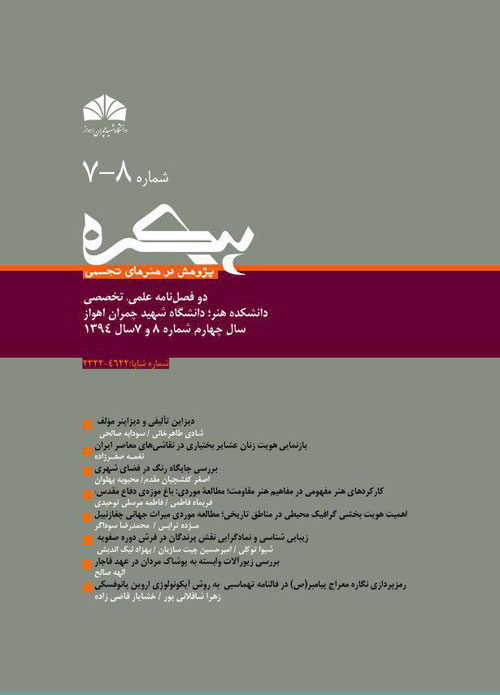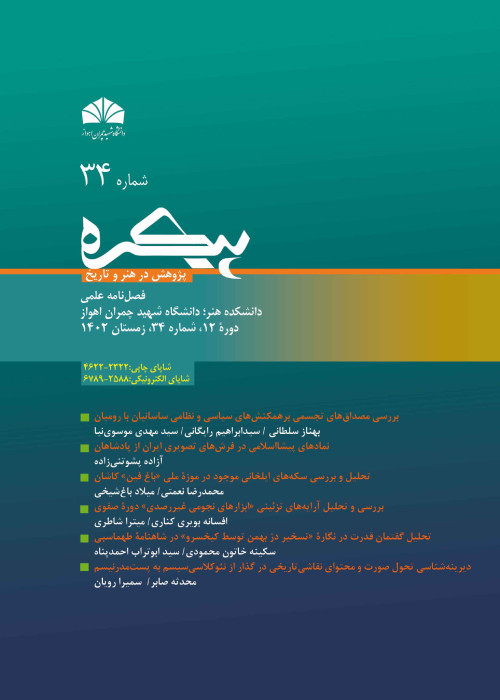فهرست مطالب

نشریه پیکره
پیاپی 8 (بهار و تابستان 1394)
- بهای روی جلد: 30,000ريال
- تاریخ انتشار: 1394/06/26
- تعداد عناوین: 4
-
صفحه 77هویت فردی، اجتماعی و بومی در سراسر جهان و از جمله کشور ما موضوعی است که بیش از پیشنیاز به بحث و بررسی دارد. دستیافتن به راهکارهای عملی برای بررسی این موضوع، مستلزم پژوهشهای میان رشتهای و پرهیز از شعارهای کلیشهای است. احیای هویت اجتماعی وبومی ایرانی تنها با زنده نگه داشتن فرهنگ و تمدن ایرانی امکانپذیر است. از این رو، بازپروری باورها و آداب ورسوم، بستری را فراهم میکند که میتواند به گروه های قومی مختلف انسجام بخشد. از این منظر، یکی از زمینه های احیای فرهنگ وهویت اجتماعی، توجه به هویت بصری گرافیک محیطی و مبلمان زیستگاه انسانی است که بازتابی از رفتار و کردار آدمی است. برهمین منوال، توجه بیشتر به فضای بومی مناطق تاریخی، بهعنوان نماد فرهنگ و تمدن یک منطقه یا یک ملت، ضروری به نظر میرسد. داده های این پژوهش با تحلیل منابع کتابخانه ای و مشاهدات میدانی گردآوری و سپس بصورت توصیفی تحلیل گردیده است. این پژوهش با نگاهی به مبلمان مناطق تاریخی، به خصوص محوطه چغازنبیل از جنبهی هویتی، بر این امر تاکید داشته است که پژوهشهایی از این دست، می تواند ضمن بازنمایی فرهنگ و تمدن با شکوه گذشته، باعث ایجاد حس قرابت، آشنایی و تداوم تاریخی در ذهن بازدیدکنندگان گردد.کلیدواژگان: هویت، گرافیک محیطی، مناطق تاریخی، چغازنبیل
-
صفحه 87به لحاظ جایگاه و تعالی هنر در ایران، عصر صفوی یکی از درخشانترین دوره های تاریخی این سرزمین است. در این دوره، صنعت نساجی و به ویژه قالیبافی، پیشرفت چشمگیری داشته است. از این حیث، اساطیر و نقوش نمادین که بخشی از فرهنگ و هنر مردماند در زمینه هایی مختلف، از جمله فرشهای صفوی، به گونهای بارز نمود دارند. از جمله نقوش نمادین پرتکرار در فرشها و منسوجات این دوره، نقشمایهی پرنده است. پرندگانی چون طاووس، سیمرغ، هدهد و طوطی به صورتهای مختلف بیشترین حضور را در فرشهای این دوره دارند. در این پژوهش ابتدا در مورد جنبه های زیباییشناسی و معنای نمادین هر پرنده در فرهنگ و ادبیات ایران بحث و سپس کاربرد نقوش آنها به صورت خاص در فرشهای صفوی بررسی گردیده است. پرنده، نمادی است از رهایی و آزادی و نمایش آن در طرح فرش، سرشار از معنا و رمز است که به زیبایی آرمانی بهشت اشاره دارد. هنرمند صفوی تمام مهارت هنری خود را به کار گرفته تا ذهنیت خویش را از زیبایی های بهشتی در یکایک عناصر طبیعت آشکار سازد و بدین سان به این عناصر، مفاهیمی رمزآمیز بخشیده است. مطالب این پژوهش به صورت اسنادی و کتابخانه ای گردآوری و به شیوهای تحلیلی، توصیفی گردیده است.کلیدواژگان: صفویه، زیبایی شناسی، نمادگرایی، پرندگان، فرش
-
صفحه 101پیشینه ی استفاده از زیورآلات وابسته به پوشاک در ایران به قبل از اسلام بر می گردد. اما با ظهور اسلام، نوع و جنس زیورآلات، به ویژه برای مردان، تغییر یافت. شدت این تغییر در هر دوره، بسته به شرایط اجتماعی، فرهنگی، سیاسی و معیشتی، نوسان داشته است. از میان دوره های مختلف، هنر در دورهی قاجار عمدتا در خدمت درباریان بود و آنان برای نمایاندن جایگاه خود، لباس هایی مزین به زیورآلات به تن می کردند. درواقع، درآن دوره، زیورآلات بیش از آن که جنبه زیبایی داشته باشد، نمایان گر میزان تمول و جایگاه اجتماعی بود. در این دوره، پوشاک، افزون بر آنکه خود تزئینات مشخصی داشت، با انواع زیورآلات جانبی و به شکل های مختلف تزیین می شد؛ زیورهایی مانند بازوبند، مدالیون، تکمه، جقه، سردوشی، ساعت و… در این میان، زیورآلات قاجاری تا حدی از نظر روش ساخت و طراحی، متاثر از هنر غرب، تحول یافت. اما این تاثیر پذیری از پایان دوره ی قاجار به بعد، چه در نوع پوشش و چه از نظر تزیینات وابسته به آن، دچار سردرگمی شد. بررسی این تحول و تاثیربرداری افراطی آن، آن هم از سوی ملتی با فرهنگ با تمدنی بسیار غنی، موضوع پژوهش حاضر است.کلیدواژگان: قاجاریه، پوشاک مردان، زیورآلات وابسته به پوشاک، تزئین
-
صفحه 113نگاره معراج در «فالنامه تهماسبی» در عهد صفوی و با بیانی نمادین، به روایت تصویری شیعی از این واقعه میپردازد. این نگاره، با ارائه تصویری متفاوت از معراج، برای اولین بار از آیکون ترکیبی «شیر و خورشید» برای نمایش پیامبر (ص) و امام علی (ع) بهره برده است. «آیکونولوژی» با اتخاذ رویکردی نظاممند، منطقی و چندوجهی، معانی نهفته در آثار هنری را تفسیر میکند. این پژوهش با همین رویکرد به تحلیل سهمرحلهای جلوه های بصری نگاره معراج میپردازد. دو مرحلهی نخست به توصیف و تحلیل «آیکونوگرافیک» نگاره میپردازد و مرحلهی سوم به تفسیر آیکونولوژی و شناسایی ارزشهای نمادین مستتر در آن اختصاص دارد. در بررسی نگارهی معراج فالنامه، این پرسشها مطرح میشود: در بررسی آیکونولوژی، چه مواردی را به عنوان معنای پنهان و ارزشهای نمادین آن میتوان مشاهده نمود و آیا با آیکونوگرافی نگاره، میتوان به شرایط خلق اثر و جهانبینی رایج دوره صفوی دست یافت؟ هدف پژوهش حاضر، بررسی آیکونولوژی عناصر بصری در این نگاره است. فرضیهی اصلی پژوهش، تاثیرگذاری شرایط دوران صفوی بر بیان نمادین در نگاره هاست. شیوهی تحقیق، توصیفی-تحلیلی است و اطلاعات به صورت کتابخانه ای و اسنادی گردآوری شده است. بررسی ها حاکی از این است که در شناخت لایه های معنایی پنهان در نگاره، استفاده از راهکار آیکونوگرافی بسیار موثر است. مطالعه آیکونولوژی نشان میدهد که آیکون ترکیبی «شیر و خورشید» در گذر زمان تداوم یافته و با تغییر ارزشهای نمادین، در جایگاهی جدید به کار گرفته شده است.کلیدواژگان: نگاره معراج، فالنامه تهماسبی، شیر و خورشید، آیکونوگرافی، آیکونولوژی، پانوفسکی
-
Page 77Individual, social and vernacular identities, all around the globe including our country, have been and will be a controversial issue. Reaching workable approaches in this respect requires interdisciplinary research and not mere making cliché generalization. Revitalizing social and vernacular Persian iden-tity is only possible through preserving Persian culture and civilization. Hence, rejuvenation of cultural beliefs and customs paves the way to restoring the unity and identity of ethnical groups. In this respect, taking into consideration the visual identity of environmental graphic design as well as the furniture of human habitats reflecting the dominated life style is one of the basic sulotions This follows that the vernacular context of historical places, as a symbol of culture and civilization of a nation (or local people), should be preserved and restored. Looking at the identity of historical places, in general and the uni-versal heritage of Chogha Zanbil, in particular, this research has focused on the issue that the similar studies, while representing the glorious culture and civilization of the post can create a sense of cultural affinity familiarity and continuity in visitors’ minds. The data were collected based on library sources and then analyzed descriptively.Keywords: identity, environmental graphic design, historical places, Chogha Zanbil
-
Page 87Historically, Safavid era is one of the most outstanding ones in Iran par-ticularly in terms of enhancement of art. In this era, the industry of textile, specially carpet weaving, could improve considerably. In this respect, mythical as well as symbolic desing as a reflection of a part of a nations art and culture, have been represented in Safavid carpets distinctively. Among the most frequently applied designs in carpets and textiles of this era, bird motifs are readily recognizable. Birds, such as peacock, phoenix, lapwing and parrot, have been represented in a wide variety of forms and shapes more than other once at fierst each brid has been discussed in terms of its aesthics and symbolic concepts and functions in Persian culture and art and the then the special application of such designs in Safavid carpets has been addressed. As symbols of freedom and redemption, birds represented in Safavid carpets are replete with mysteries alluding to the ideal beauty of the Heaven. Safavid artists, did their best to represent their mentality of heavenly beauties of individual nat-ural elements in a remarkably artistic way. As such, the elements have been given mystical concepts. The data were gathered attributively based on library sources and then analyzed descriptively.Keywords: Safavid carpets aesthetics symbolism birds
-
Page 101The history of applying ornamentations to clothes and dresses in Iran dates back to Pre-Islamic era. With appearance of Islam, however, the kind and material of ornamentations, especially for men, changed. The intensity of this change, depending on different social, cultural, political and economic con-ditions in each historical era has been different. Among the various historical eras, art in Qajar era was mainly at the service of Royalties. In fact, they wore ornamented clothes and dresses in order to draw attention to their status. In other words, ornamentations in Qajar era were more used as a social and wealth indicator than aesthetic purposes. In Qajar era, clothes and dresses, in addition to their own attachments, were adorned with additional ornamenta-tions in different ways. The ornamentations included armbands, medallions, buttons crests strips watches etc. Altogethers under the influnec of western art, the art in Qajar era underwent evolution in terms of design and pro-duction. However, from the end of Qajar era on, this impressionability, both from the aspect of clothing and of associated decorations, experienced a state of confusion. This study aimed to study this extreme impressionability.Keywords: Qajar, men’s clothing, decorationsassociated with clothing decoration
-
Page 113The image of the Islam Prophet’s(pbuh) Ascent depicted in Falnameh Tah-masbi in Saavid era represents a Shia version of the holy event symbolically. Showing a different pictorial version of the Ascent, the image has taken ad-vantage of applying the combined sun-and lion icon to represent the Prophet (pbuh ) and imam ali (pbuh) for the first thme . Adopting a systematic logical and interdisciplinary approach, iconology tries to interpret the latent meanings in artworks. The present study aimed to interpret the image of the Prophet’s (pbuh) Ascent with the help of the mentioned approach in three distinct phases the first two phases dealt with description and analysis of the image and the third one addressed the interpretation revealed by iconology and identified the latent symbolic values in the image. The questions of the research included 1- what cases can be interpreted as the latent meanings as well as symbolic values in iconology? and 2- Is it possible to have a general understanding of the circumstances and the common ideology of Safavid era in which the image has been created? The objective of this research was to address the iconology of the visual elements of the images related with the event of the Ascent. The hypothesis of the study was that the circumstances of Safavid era have had impact on the symbolic expression of the images. The methodology conducted is descriptive-analytic in nature. Also, the data were gathered based on library and database sources. The results indicated that iconology approach is particularly effective in identifying the latent conceptual layers in the imag-es. The results also revealed that the application of the combined sun-and-lion icon has continued in time, however, as the symbolic values changed, a func-tion shift has occurred in the application of the iconKeywords: the Ascent image Falnameh, Tahmasbi, iconology, Panofsky


